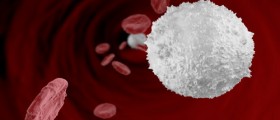
Platelets – Formation and Function
Human blood has several different types of cells suspended in the blood liquid (or blood plasma). It consists of white blood cells (WBC, leukocytes), red blood cells (RBC, erythrocytes), and platelets (thrombocytes). Normal thrombocytes are of irregular shape and don’t have a nucleus.
These blood cells are formed from bone marrow cells (megakaryocytes). Every megakaryocyte cell produces 5 to 10.000 of thrombocytes. Every day, our body produces more than a 1.000 of these cells and they live for 5 to 9 days. After that time, Kupffer and phagocytes cells destroy old thrombocytes, making the space for new blood cells. The spleen acts as the reservoir for platelets and it releases some of them when needed.
Thrombocytes have a role in blood coagulation, which gets very important after some injury. These are the first cells to come to the injured spot on the body. Once they arrived they leak from the blood and heal the injury forming blood clots.Platelets Range
Normal platelet range is about 150.000 and 400.000 per μl (microlitre) of blood in humans. Children might have slightly higher upper limit, about 450.000 platelets and pregnant women often experience decrease of platelet number. Pregnant women shouldn’t worry about their platelet number if it’s above 100.000 per μl, but if/when the numbers go down, she should consult her doctor.
Women normally experience decrease of platelets in the blood every month, before menstruation.
Increase or decrease of platelet count might have serious health consequences and even be a life threat. Because of that fact, it is very important to maintain normal platelet count in the body. There are medications helpful to increase and decrease your platelet count. Your doctor will discuss your blood test results and suggest medications, if needed.Low Platelet Count
Thrombocytopenia (low platelet count) can severely affect the healing properties of your body. There might be increased usage in the body, decreased production or increased destruction of these blood cells which cause this condition. Idiopathic Thrombocytopenic Purpura (ITP) is one of the causes of thrombocytopenia, when there is an increase of destructed platelets.
Specialists consider 50.000 thrombocytes per μl as the bottom line. Everything under 50.000 will be a life threatening platelet count.High Platelet Count
This is a condition also known as thrombocytosis and it might be caused by injuries, medications, diseases or surgical procedures. Body might be disabled to destroy old platelets or there might be an increase of produced platelets.
Thrombocytosis can cause formation of blood clots in the brain and blood vessels, leading to strokes and heart attacks. Anything above 1.000.000 platelets per μl is considered to be dangerous for your health.Platelet Donation
If you have normal platelet count and feel healthy and ready to help, you can donate your blood to the people that need it. Donated blood will be used to help people suffering from many diseases and your blood cells might help several ill people.
















Your thoughts on this
Loading...